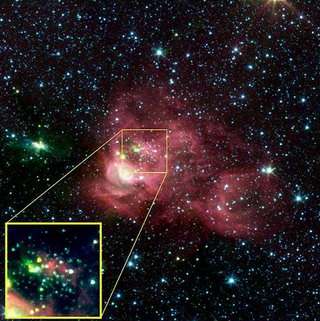Researchers Discover New Star Clusters in Milky Way

Boston University researchers led a team of astronomers who recently discovered nearly 100 new star clusters in the Milky Way, each containing tens to hundreds of never before seen stars. Astronomy Professor Dan Clemens and Emily Mercer, a BU doctoral student, are members of the multi-institutional Galactic Legacy Infrared Mid-Plane Survey Extraordinaire (GLIMPSE) team.
Image: Stars Play Hide and Seek in the Milky Way
Using the dust-piercing infrared eyes of NASA’s Spitzer Space Telescope, Mercer, the discovery’s lead investigator, developed a computer method which used an algorithm to automatically sift through GLIMPSE data and identify high star density areas to look for clusters. She believes the new clusters will tell astronomers a great deal about the structure of the Milky Way and star formation within the galaxy.
“These little guys were quite hard to find,” said Mercer. “The discovery required sophisticated computer sifting of GLIMPSE data and careful inspection of the Spitzer images.”
Because the Sun and its solar system sit inside the Milky Way’s flat disk, from Earth, most of the galaxy is seen to be concentrated in a blurry band of light that stretches across the sky, known to astronomers as the galactic plane. Many of the stars in the plane cannot be seen with visible-light or ultraviolet telescopes because the clouds of dust and gas that fill the galactic spiral arms block their starlight from view.
“Emily has done a great job,” said Clemens, her BU advisor. “Her computer method for finding clusters has proved to be the most successful automated effort to date. The infrared light we’ve used is able to see through the dust better than optical light. It’s the difference between trying to see through fog and looking out on a clear day. But Emily’s computer program improved on that by telling us where in this huge data base to look for new clusters.”
By turning Spitzer’s heat-seeking infrared eyes on the Milky Way’s plane, the cold clouds of galactic gas and dust became transparent, revealing almost 100 new star clusters. Two-thirds of the new clusters were discovered through the computer method Mercer developed and the rest were found using the traditional method of visually scrutinizing GLIMPSE images for star clusters.
In addition to uncovering hundreds of hidden stars, Mercer also found that there are nearly twice as many star clusters in the portion of the galactic plane only visible from Earth's southern hemisphere, than in the northern galactic plane. She suspects that this observation may reveal to astronomers the location and nature of the Milky Way's spiral arms, the long, bright lanes of hot, massive stars seen in other galaxies, but hidden by the dust in our own.
The multi-institutional GLIMPSE team is led by Professor Edward Churchwell of the University of Wisconsin-Madison, and includes Clemens, Mercer, and other researchers in the Boston University Institute for Astrophysical Research as well as researchers at other institutions. The group was approved to survey the galactic plane with Spitzer’s Infrared Array Camera (IRAC) in November 2000, as part of Spitzer’s Legacy program. Thus far, more than 30 million stars in the inner Milky Way have been catalogued by GLIMPSE, and the team expects to identify more than 50 million stars by the end of the project.
“By making the galactic plane transparent, Spitzer opens a new door for astronomers to study the Milky Way,” said Churchwell. “Some of the most interesting science likely to come out of this project will be serendipitous discoveries, which opens up entirely new avenues of inquiry.”
Mercer’s findings are published in the December 10 issue of The Astrophysical Journal.
The Jet Propulsion Laboratory (JPL) manages the Spitzer Space Telescope mission for NASA’s Science Mission Directorate, Washington. Science operations are conducted at the Spitzer Science Center at the California Institute of Technology in Pasadena, California. JPL is a division of Caltech.
Boston University, with nearly 30,000 students enrolled in its 17 schools and colleges, is the fourth-largest independent university in the United States.
Source: Boston Univetsity















